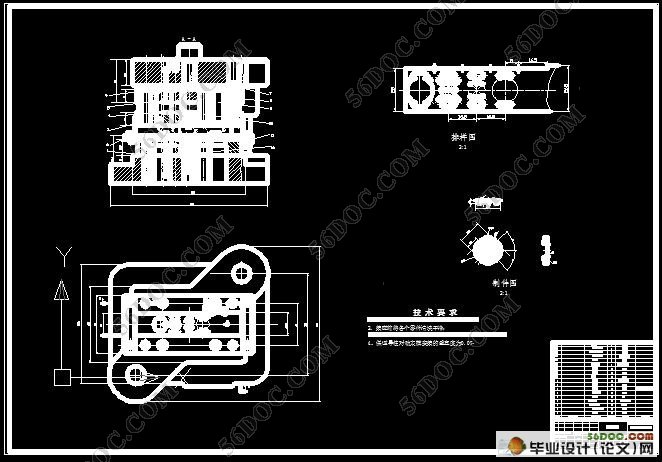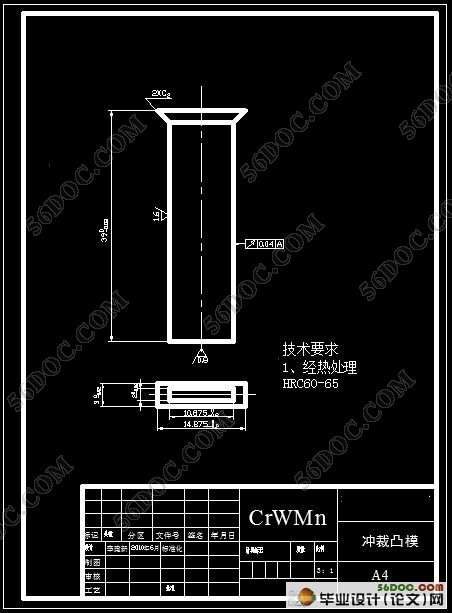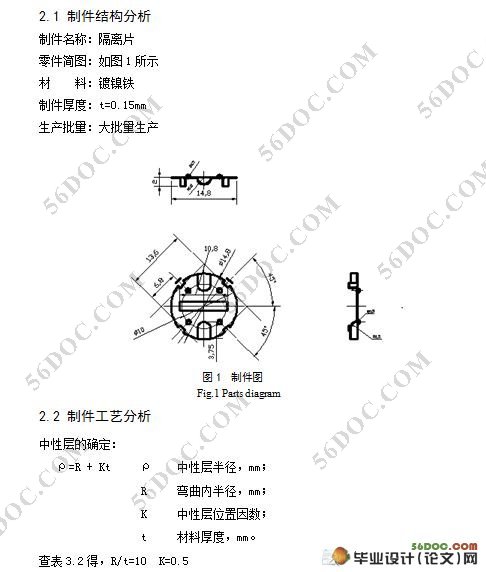隔离片多工位级进模设计
无需注册登录,支付后按照提示操作即可获取该资料.
隔离片多工位级进模设计(含任务书,开题报告,中期检查表,论文说明书10000字,CAD图纸11张)
摘 要:本毕业设计是对隔离片的工艺进行整体分析, 在这个基础上设计出一付能生产出合格产品的设计计算。此级进模工艺主要有压包、冲孔、切弯、落料;模具设计主要包括排样设计,凸凹模刃尺寸的设计计算、冲压力的计算及模具压力中心的确定、模具非标准件的设计计算、压力机的选择及其校核。
关键词: 级进模; 压包; 冲孔; 切弯; 落料
The Design of Multi-Position Progressive Die for Shaping Pieces
Abstract: The graduation project is the support of the technology of insulate the overall analysis, based on the design of this pair can produce qualified product design calculations. This process mainly includes punching, cutting, bending and blanking; the design of the die includes layout design, the size of punch blade design and calculation, the calculation of the pressure impulse and the determination of center of pressure die and mold design and calculation of non-standard parts, press machine select and check.
Key words: progressive die; punching;cutting;bending;cutting edge;



目 录
摘要……………………………………………………………………………1
关键词…………………………………………………………………………1
1前言……………………………………………………………………………1
2制件分析……………………………………………………………………2
2.1制件结构分析 ………………………………………………………………2
2.2制件工艺分析 ………………………………………………………………3
3冲压工艺方案的确定……………………………………………………………………3
3.1排样的设计计算 …………………………………………………………………4
3.2冲压力的计算 ………………………………………………………………5
3.2.1凸模厚度 …………………………………………………………………5
3.2.2计算冲裁力 ………………………………………………………………6
3.2.3压包力的计算 ……………………………………………………………6
3.2.4弯曲力的计算 ……………………………………………………………6
3.2.5 制件与版料分离 …………………………………………………………7
3.3模具压力中心的计算 ……………………………………………………………7
3.4弯曲回弹的计算 …………………………………………………………………9
4模具设计计算……………………………………………………………………9
4.1凸凹模刃口尺寸的确定 …………………………………………………………10
4.1.1 一区凸凹模的刃口尺寸确定……………………………………………10
4.1.2 二区凸凹模的刃口尺寸确定……………………………………………12
4.2弯曲凸模工作部分的尺寸计算…………………………………………………13
4.3凸凹模的结构设计 ……………………………………………………………15
4.3.1 凸模结构设计……………………………………………………15
4.3.2 凹模结构设计……………………………………………………16
4.4定位、导向、推荐、卸料装置的设计……………………………………………16
4.4.1 导正销……………………………………………………17
4.4.2 浮动导杆……………………………………………………17
4.4.3 导向零件……………………………………………………17
4.4.4 卸料推件装置……………………………………………………18
5模具闭合高度的计算和校核及压力机的选择…………………………………………18
5.1模具闭合高度的计算 ……………………………………………………………19
5.2压力机的选择及校核 ……………………………………………………………19
6结论………………………………………………………………………………………20
参考文献 ………………………………………………………………………21
致谢……………………………………………………………………………21
